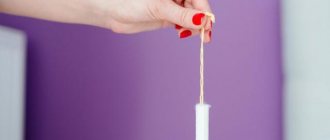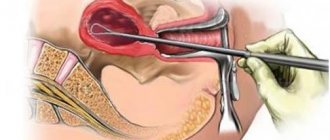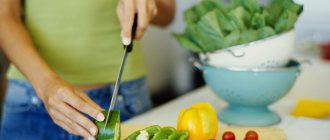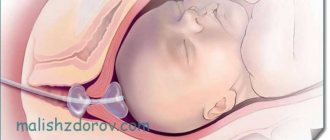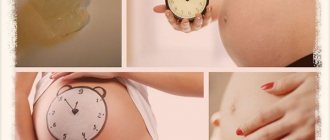Stitches after childbirth: how long can you sit - the most common question
When the perineum ruptures, healing occurs relatively quickly, but entails some problems.
- Painful sensations cannot be avoided; intradermal sutures (internal cosmetic) bring less suffering, especially when sitting, than external sutures (photo).
- After a week, there is usually an improvement and you can practically sit without restrictions.
Obstetricians recommend that mothers in labor, if they have regular sutures after childbirth rather than internal ones, mothers don’t know how long they shouldn’t sit, then not sit for several days to two months, depending on the severity of the problem and the area of application. You can eat and feed your child while lying down or standing up. If absolutely necessary, a “half-sitting” position is allowed, for example, in transport. It is strictly forbidden to lift a load more than the weight of your child and not to sit upright.
If there are stitches after childbirth, how long can you sit?
In the perineal area, threads are used that take longer to dissolve, given the traumatic nature of this location. Internal sutures after childbirth, how long it takes to heal as described above, take longer to heal, for example, on the uterus (photo above), the abdominal wall up to 5 months, or even up to six months, they do not need special care. To speed up your return to active life, you need to:
- maintain hygiene;
- use antiseptics;
- rest more often.
How long does it take for external and internal sutures to heal after childbirth? Healing is also affected by the general condition of the body, the ability to regenerate soft tissues, the state of the immune system, age, weight, following a low-calorie (non-fatty, light food) diet to avoid constipation and not damage the integrity of the sutures, straining connective tissues. The regularity of treating sutures with solutions after childbirth, how long they heal as described above, especially after each visit to the toilet, the frequency of changing sterile dressings and sanitary pads, and wearing non-constrictive (or better yet, disposable) underwear also affects the duration of the process of repairing sutures after childbirth.
It is advisable:
- avoid hypothermia, which can lead to inflammation;
- abstain from sex for a while.
Of course, there is a risk of divergence of the sewn zones, in the same perineum, because postpartum discharge is a favorable environment for microorganisms. To avoid infection entering the birth canal, compliance with possible precautions is encouraged.
For those who know how long it takes for sutures to heal after childbirth, they enjoy the benefits of traditional medicine - blackberry syrup with echinacea is recommended, 3 times a day, one teaspoon before meals. Drink for two weeks.
Proper care will significantly speed up recovery.
How are stitches removed?
Before discharge, the doctor usually warns on what day the sutures are removed after childbirth: in the normal course of the healing process, this occurs 5-6 days after their application. If a woman’s stay in the maternity hospital is prolonged, and she is still in the hospital at that moment, this procedure will be performed on her there. If the discharge occurred earlier, you will have to come again.
And yet, the main question that concerns all women undergoing this procedure is whether it hurts to remove stitches after childbirth and whether any anesthesia is used. Of course, the doctor always reassures that this procedure only resembles a mosquito bite. However, everything will depend on the woman’s pain threshold, which is different for everyone. If there were no complications, there will actually be no pain: only an unusual tingling mixed with a burning sensation is felt. Accordingly, anesthesia is not required.
Childbirth is an unpredictable process, so anything can happen. However, ruptures are not uncommon and are not perceived by doctors as a complication or difficulty. Modern medicine involves professional, competent suturing after childbirth, which subsequently causes a minimum of discomfort with proper care.
New articles
we are in social networks
Sometimes it happens that during childbirth the soft tissues are torn or cut by the doctor. You have to get stitches after giving birth . This happens for various reasons.
Moms are very worried about how further events will develop:
- how long will it hurt
- how to care for a seam
- when can i sit down
- how to sit with a stitch
- what to pay attention to
- When will normal sexual intercourse become possible...
Let's discuss everything. I would be glad to read in the comments your experience of recovery from tears or episiotomy.
1. When and where ruptures occur, and when is an episiotomy necessary?
Ruptures occur when the elasticity of soft tissues is reduced or the size of the fetus is large. The elasticity of tissues is genetic and can decrease due to inflammatory processes in the vagina (candidiasis causes inflammation of the mucous membrane of the vagina and vulva). Therefore, discuss the need for prenatal vaginal sanitation with your gynecologist in advance.
Rupture can occur in various places
- Cervix
- vaginal walls
- perineal tissue
To prevent deep tears, your doctor may decide to perform an episiotomy. It is also carried out if it is necessary to shorten the period of pushing (according to indications from the fetus or mother).
In this case, a surgical incision is made in the perineum from the commissure of the labia to the back, slightly at an angle (to the right or left). The procedure is unpleasant, but you can survive it. As is our custom, men discuss battle wounds and scars, and women discuss postpartum scars.
2. How will we sew it up?
Depending on the severity, the doctor will suggest a type of pain relief: local anesthesia (Novocaine or Lidocaine) or short-term intravenous anesthesia (extremely rare and in particularly severe cases).
Then he will compare the soft tissues using sutures.
We won’t go into details; this is an unpleasant topic.
Most often, self-absorbable threads are used; they do not require the removal of sutures. The suture can be continuous - one knot at the beginning, the second at the end of the wound, and can consist of separate stitches. The most pleasant option for external seams is a cosmetic seam. It passes inside the soft tissue and does not show the needle entry and exit marks, as with conventional sutures.
The procedure for suturing and episiotomy is quite painful and unpleasant. This pain, like labor pain, is quickly forgotten, as Mother Nature intended.
Another thing is that in the postpartum period, sutures cause significant discomfort to the mother.
Despite this, women note that they will happily go to the next birth - the happiness of motherhood is the brightest experience in a mother’s life.
3. Caring for sutures, when and where to remove sutures
Caring for sutures involves maintaining cleanliness of the perineum and sexual peace.
Discuss drug treatment with the doctor who delivered the baby. Check with him about the need and timing of suture removal.
Solcoseryl, sea buckthorn oil, and rosehip oil are often recommended for external seams - they accelerate healing, disinfect, and soften the skin. A solution of brilliant green, iodine and potassium permanganate greatly dry the skin, it becomes tense, thereby causing pain.
Try to wash yourself after every visit to the toilet.
Change gaskets as needed, but at least once every 2 hours.
Before standing up, tighten your pelvic floor muscles - just tone them.
You cannot sit straight for the first 7-10 days. The seams may come apart, and sitting is painful. You can sit on the toilet and a special inflatable ring. You can also sit half sideways in the “mermaid pose.” You will have to feed lying on your back or side.
On the next working day after discharge, visit the gynecologist who managed your pregnancy. Moreover, he must be given a tear-off sheet from the exchange card. The doctor will examine the stitches, remove them if necessary, or tell you when to come and remove them.
4. We promote the restoration of soft tissues
First of all, we will pay attention to perineal hygiene and following the doctor’s instructions (what to wash with, how to treat sutures).
Commercially produced pads may not be suitable and may increase discomfort. An old sheet cut into pieces will come to the rescue. With such a homemade gasket, the skin breathes better. In addition, a thick pad fixes the wound and soothes the pain.
Air baths are very useful for speedy healing of wounds. Due to postpartum discharge - lochia, the time spent without underwear is limited. I advise you to use a hairdryer with cold air to dry the seams.
The very thought of going to the toilet is scary. A piece of toilet paper applied to the seams will help. By manually holding the perineum, you can facilitate the process of urination and defecation and reduce fear.
Use Kegel exercises :
While urinating, try to stop the urine by contracting the muscles of the perineum - remember, this is a sensation.
Then, in a comfortable environment, tense and release these muscles for 10 seconds, rest a little and repeat the exercise again. Try to do it several times a day, gradually increasing the number of approaches.
This will not take much time, will improve blood circulation in the pelvis and speed up recovery. You can use exercises if they do not cause pain .
Self-dissolving sutures will begin to disintegrate within a week. The threads completely dissolve in about two months. The doctor can remove them earlier, which will reduce everyday discomfort.
After the wound has healed, you can massage the perineum with vegetable oils. Massage promotes rapid resorption of the scar. Scars after ruptures or episiotomies heal in different ways, from two to twelve months.
After childbirth, strict sexual rest is recommended for two months, until lochia stops and the uterine lining is restored. After this period, you can try to experience physical intimacy. During sexual intercourse, pain may occur in the suture area. I advise you to stock up on a special water-based lubricant in advance.
The lubricant will moisturize the seams and reduce pain during sexual intercourse. In addition, due to the hormonal background after childbirth, women experience vaginal dryness, and natural lubrication is almost not released. The lubricant will provide the necessary hydration and help you enjoy intimacy.
5. What to pay attention to
Complications in the suture area are extremely rare, however, if you notice one of the symptoms listed below, seek medical help immediately.
- very severe pain when changing body position, walking
- increase in body temperature
- traces of pus on the pad
- increased bleeding from the wound
- wound dehiscence
Conclusion
Take care of yourself, the more attentive you are to yourself during the postpartum period, the sooner your body will recover, the wounds will heal, and the pain of childbirth will be forgotten.
Try to concentrate on caring for your child; you are now in the period of getting to know him. When carrying a child, the abdominal muscles tense, increasing abdominal pressure inside, which in turn puts pressure on the sutures, causing pain.
Avoid wearing a postpartum bandage - it contributes to an even greater increase in intra-abdominal pressure.
Use a sling to carry your baby. It will evenly distribute the load over the mother’s body, making caring for the baby more enjoyable. Involve assistants in household chores as much as possible. And all will be well.
Thanks for sharing the article on social media. All the best!
Sincerely, Elena Dyachenko
Situations that lead to stitches
During a natural birth, there are two situations in which sutures are necessary: a rupture of the cervix and an incision in the perineum. Uterine rupture occurs when the cervix is not fully dilated when the woman begins to push. The baby's head puts pressure on the uterus, causing the uterus to rupture.
The obstetrician makes an incision in the perineum in the following cases:
- Quick birth.
- Premature birth.
- Breech presentation of the baby.
- Anatomical features of the perineum of a woman in labor, for example: inelasticity of tissue or the presence of a scar from a previous birth.
- Doctors contraindicate pushing for a woman in labor, for example, due to myopia and other reasons.
- Threat of perineal rupture.
All reasons for cutting the perineum have one goal - to facilitate the passage of the child through the cervix, in order to avoid injuries to the child's head. When the perineum is cut with a scalpel, the edges are smooth, and accordingly, the healing of the sutures occurs faster than with uneven edges formed during a rupture. When a baby is born as a result of a cesarean section, the woman in labor has sutures after childbirth on the anterior abdominal wall.
Why can stitches hurt?
This is a normal phenomenon, because there was a gap. After the anesthesia wears off, the stitches may begin to hurt. The fact is that most young mothers breastfeed their children, so painkillers are contraindicated for them. The doctor can prescribe drugs with local action in order to somehow alleviate the patient’s plight. However, if everything is in order, there are no complications, and the woman follows all the rules, the pain should go away very soon. After suturing, you cannot sit normally for the first week. This must be done with caution and put stress on the buttock that is located on the opposite side of the seam. You can sit on the toilet almost immediately, but do not linger on it for too long and do not push too hard.
How quickly do they heal?
“How quickly do stitches heal after childbirth?” - you ask. Healing of sutures after childbirth is the process of restoring the soft tissue of the perineum. Sutures are applied using various materials, depending on the indications, technique, capabilities and other circumstances.
The following types of materials exist:
- natural or synthetic self-absorbable,
- non-absorbable
- metal brackets.
With self-resorption of sutures, wound healing occurs from 1 to 2 weeks, sutures dissolve in about thirty days. When using staples and non-absorbable material, threads or staples are removed after childbirth on average on the fifth day. Wound healing occurs from 2 weeks to 1 month, depending on the size and cause of the suture.
After what time can you take a bath?
1.
Your birth took place without cuts and in a natural way, wait for the end of the lochia discharge and take a bath (on average 2-3 weeks).
The water temperature should be at body temperature, not higher!
2.
Delivery with cuts and stitches, you need to wait for the stitches to completely heal, the time varies from 2 weeks to 2 months, depending on your body and skin tissue (their speed of regeneration).
It is also forbidden to warm yourself in the shower!
3.
Caesarean section, bathing is allowed only after 2-3 months, consult your doctor first.
In general, any specialist will recommend a period of 1.5 months without bathing.
Benefits of taking a bath:
- soothes muscles and relieves pain;
- fills with energy;
- improves blood circulation;
- helps skin regeneration;
- relaxes;
- promotes the production of the hormone oxytocin, which is responsible for uterine contractions and milk production in the case of breastfeeding;
- gives a feeling of freshness.
Treatment of sutures after natural childbirth
In order for the wounds to heal faster, to prevent infection and to reduce pain, it is necessary to care for the sutures after childbirth. For stitches on the cervix and vaginal walls, normal hygiene rules must be observed. Such sutures are always applied with self-absorbing material; no additional care is required for such sutures.
In the maternity hospital, the sutures on the perineum after childbirth are treated by a nurse twice a day, using a solution of “potassium permanganate” or a solution of “brilliant green,” popularly called “zelenka.” Sutures on the perineum are also usually applied with absorbable threads. The suture knots fall off around the fourth day. If, for some reason, sutures were placed with non-absorbable material, the sutures are removed on the 4th day of stay in the maternity hospital.
How long can you sit after childbirth?
At home, you need to follow simple rules of personal hygiene. Try to change your maternity pad every two hours, use special disposable maternity panties or loose cotton underwear. During the wound healing period, you should not use figure-shaping underwear, as it puts pressure on the perineum, which impairs blood circulation, preventing wound healing. And also seam fraying occurs due to the non-breathable stretch material of the underwear. You need to wash yourself morning and evening using baby soap, and after each visit to the toilet. It is necessary to rinse the seam well by simply directing a stream of water at it. After washing, dry the perineum by blotting it with a towel. Following washing, it is recommended to treat the seams with Miramistin solution and let them dry naturally.
If the stitches are on the perineum, the woman is not allowed to sit down for ten days. This does not apply to going to the toilet, since you can sit on the toilet already on the first day after the baby is born. As a rule, stool appears on the third day, since a cleansing enema is given before childbirth, and during childbirth the woman does not eat. To avoid constipation, you can drink a spoonful of vegetable oil before eating, then the stool will become soft and will not affect the healing of the sutures. And also do not eat food that has a fixing effect.
If the scar hurts
Girls are faced with a problem when the wound almost heals, but the tissues hurt. In rare cases, it is just a nagging pain that will go away as soon as the tissues have completely grown together, but more often the pain signals the danger of infection.
Check the area around the perineum for rashes and inflammation. If you have any concerns about a healing tear, consult your obstetrician.
To speed up the regeneration process, experienced doctors prescribe physical procedures or quartz treatment to patients. But such therapy cannot be prescribed earlier than 14 days after resolution of the burden.
If the wound does not heal well and the scar turns out to be large, convex and stands out sharply against the background of smooth tissue, the gynecologist may recommend special ointments for healing. They are smeared on the surface in the morning and evening for 2-3 weeks. The result is not always very noticeable, but it is possible to slightly alleviate the patient’s suffering in this way.
Read also: Why did I stop loving and hating my husband after the birth of my child?
Remember that after childbirth you should not overstrain your genitals and you must carefully observe the rules of hygiene - then pain will be minimal.
Treatment of sutures after caesarean section
After a caesarean section, care must be taken to carefully clean the sutures after childbirth. While you are in the maternity hospital, the treatment nurse cleans the sutures daily with antiseptic solutions and changes the dressing. On the fifth or seventh day, the sutures and bandage are removed, if the suture was not applied with absorbable material. Such threads dissolve in up to eighty days. The skin scar was formed already on the seventh day after surgery.
A caesarean section is a surgical procedure where an incision is made through all layers of the anterior abdominal wall. As a result, the woman in labor is bothered by pain in the suture area; from the first days in the maternity hospital, an intramuscular anesthetic injection is administered. It is also necessary to wear a special postpartum bandage. To prevent the sutures from coming apart after childbirth, the mother in labor is not recommended to lift weights greater than the weight of the child.
What are the complications of sutures?
If the sutures are not properly cared for and precautions are not taken during the healing period, complications may arise. This is suppuration, discrepancy and pain in their locations. Let's consider each type of complications in order:
- Suppuration. In this case, severe pain occurs, swelling of the wound, and purulent discharge are observed. Body temperature may increase. This outcome occurs when there is insufficient attention to personal hygiene or an infection that was not cured before delivery. If you suspect that the sutures are festering, you should immediately consult a doctor who will prescribe the correct treatment.
- Pain. This does not apply to the painful sensations that occur in the first days after the suture is applied. Pain often indicates infection, inflammation, or some other problem, so it's best to see a doctor. It is not advisable to self-medicate; only a doctor can prescribe the necessary procedures and medications.
- Discrepancy. This rarely happens with internal seams; they often come apart if they are located on the crotch. The reasons for this may be early sexual activity after childbirth, infection, sitting down too early and sudden movements. When the stitches diverge, the woman experiences severe pain and there is swelling of the wound, which sometimes bleeds. Sometimes the temperature rises, which indicates infection. A feeling of heaviness and fullness indicates the presence of a hematoma.
Normally, pain in the suture area goes away approximately 2 weeks after birth. If there was a caesarean section, the period of pain can last up to a month. If after this time the stitches still bother the new mother with pain, then it is necessary to consult a doctor. This signals that something is interfering with the normal healing of the sutures. You should not delay contacting a gynecologist, as the consequences can be very serious.
We suggest you read: What does prickly heat look like in a newborn and what to do about it
Stitches hurt after childbirth
If examination of the sutures by a gynecologist does not reveal any serious abnormalities, then the doctor may prescribe heating. It is aimed at eliminating pain and accelerating the healing of sutures. Warming is carried out using an infrared, quartz or “blue” lamp, which is held above the seam area at a distance of at least 50 cm.
If the seams come apart
1. After a thorough examination, the doctor will stitch you again.
2. If the tightening process is almost complete, then no action will be needed.
If a discrepancy is detected, you should not rely on the fact that the wound has already healed and you can do without calling a doctor. This can also become a complication during the next pregnancy and childbirth. It's better to play it safe and contact your gynecologist.
Itching and feeling of "tightening"
These symptoms are not usually a sign of serious problems. If a woman experiences stretching in the area of the stitches or itching (without redness), this only means that they are in the stage of active healing. This is a good indicator. However, if these factors cause discomfort to the mother, you can contact your gynecologist and ask to prescribe an ointment to eliminate the itching.
Festering
Absolutely all stitches can fester: internal and external, and after a caesarean section. On the outside it will immediately become noticeable. But the decay of the internal seams will be characterized by an unpleasant brown-green discharge. In any case, the appearance of pus is an alarming symptom that requires urgent medical attention.
Bleeding
This situation is not uncommon and is often associated with the mother’s failure to comply with the rules of behavior in the postpartum period. For example, if a woman begins to sit down on both buttocks earlier than two weeks after suturing. Tissue tension occurs, the wounds become exposed and begin to bleed. Healing ointments usually help eliminate the problem. However, for your peace of mind, it is better to contact a gynecologist and make sure that repeated suturing is not required.
Every second woman needs stitches after giving birth. It is almost impossible to prevent ruptures, however, you can really reduce the chances of their occurrence. To do this, a woman in labor must do everything that depends on her. First of all, listen to your doctor and don’t panic. During delivery, the entire process is controlled by an obstetrician-gynecologist, and if necessary, he will make an incision himself.
If stitches were placed, the speed of their healing depends on the woman. If all the rules are followed, the stitches will heal quickly and without much concern.
Very often, a woman continues to feel pain and discomfort even after two weeks after giving birth. This is a signal that something has interfered with healing, and this is fraught with various complications - in this case, medical intervention, treatment, and treatment of sutures after childbirth with special preparations will be required.
- if the scars do not heal for a very long time, they hurt, but during a medical examination no pathologies or special problems were identified, the doctor may recommend warming up;
- they are carried out no earlier than 2 weeks after birth to allow the uterus to contract (read more about restoration of the uterus after childbirth);
- For this procedure, “blue”, quartz or infrared lamps are used;
- heating is carried out for 5-10 minutes from a distance of 50 cm;
- it can be done independently at home after consulting a doctor;
- Kontraktubeks suture healing ointment can also relieve pain: applied 2 times a day for 2-3 weeks.
We suggest you read: What can you eat at night when losing weight: foods that can be eaten in the evening and for dinner - fruits (tangerines, khurama, kiwi), cottage cheese, a list of allowed foods before bed for those losing weight
The seam has come apart:
- if after childbirth the seam comes apart, it is strictly forbidden to do anything at home;
- in this case, you need to call a doctor or an ambulance;
- if suture dehiscence was actually diagnosed after childbirth, most often they are reapplied;
- but if the wound has already healed, this will not require any medical intervention;
- in such cases, after examination, the doctor will prescribe how to treat the sutures after childbirth: usually wound-healing ointments or suppositories.
- very often women complain that their sutures itch after childbirth, and very much so - as a rule, this does not indicate any abnormalities or pathologies;
- itching is most often a symptom of healing, and therefore should not cause anxiety in a woman;
- in order to somehow alleviate this unpleasant, albeit favorable symptom, it is recommended to wash yourself more often with water at room temperature (the main thing is not hot);
- This also applies to those cases when the seam is pulled: this is how they heal; but in this case, check yourself to see if you started sitting down too early and if you have to carry weights.
Festering:
- if a woman notices unpleasant, abnormal discharge (not to be confused with the restoration of menstruation), smells bad and has a suspicious brownish-green color, this may mean suppuration, which poses a serious health hazard;
- if the suture festers, you should definitely tell your doctor about it;
- this is how complications such as inflammation of the sutures after childbirth or their divergence can occur - both cases require medical intervention;
- if infection occurs, antibiotics may be prescribed;
- For external treatment, it is recommended to smear with Malavit shvygel, Levomekol, Solcoseryl, Vishnevsky ointments;
- if the scars fester, only a doctor can prescribe what can be used to treat them: in addition to the above-mentioned anti-inflammatory and wound-healing gels and ointments, chlorhexidine and hydrogen peroxide are also used, which disinfect wound cavities.
Bleeding:
- if after childbirth there is sutureitis, most likely, the basic rule was violated - do not sit during the first weeks: the tissues are stretched and the wound surfaces are exposed;
- in this case, it is not recommended to treat the problem area yourself with something, but to contact a specialist directly;
- alterations may be required;
- but most often it is enough to use wound-healing ointments and gels (Solcoseryl, for example).
If the first days pass without complications and special difficulties described above, there remains one more procedure - removal of sutures after childbirth, which is performed by a specialist on an outpatient basis. You also need to mentally prepare for it so as not to panic and be afraid.
Complications after childbirth
If the sutures come apart after childbirth: pain, redness, and discharge appear in the suture area, you must urgently consult a gynecologist, as inflammatory complications have arisen.
Depending on the complication, for example, the sutures on the perineum have come apart or the wound is suppurating, the doctor will prescribe local treatment. In case of purulent-inflammatory complications, the sutures are treated using Vishnevsky ointment or synthomycin emulsion; after the pus is released and the wound begins to heal, levomekol is prescribed, which accelerates the wound healing process. By following simple hygiene rules, you can avoid complications. Be healthy!

